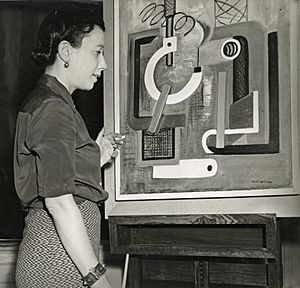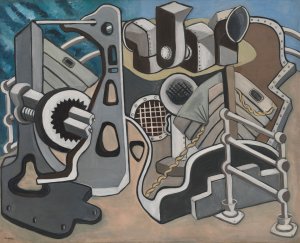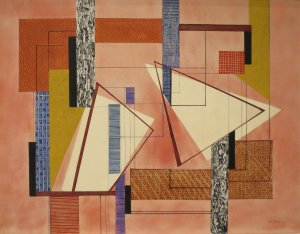I. Rice Pereira facts for kids
Quick facts for kids
I. Rice Pereira
|
|
|---|---|

Pereira, 1938
|
|
| Born |
Irene Rice
August 5, 1902 Chelsea, Massachusetts, United States
|
| Died | January 11, 1971 (aged 68) Marbella, Spain
|
| Nationality | American |
| Education | Art Students League of New York, Traphagen School of Fashion |
| Known for | Painting, writing, poetry, philosophy |
| Movement | Bauhaus |
| Spouse(s) | Humberto Pereira (m. 1929–1938; divorced), George Wellington Brown (m. 1941–?; divorced), George Reavey (m. 1950–1959; divorce) |
| Relatives | Juanita Guccione (sister) |
Irene Rice Pereira (born August 5, 1902 – died January 11, 1971) was an American artist, poet, and thinker. She was very important in shaping modern art in the United States. Pereira is famous for her abstract art, especially her geometric abstraction and abstract expressionism. She also used ideas from the Bauhaus school, which focused on art, craft, and technology. Her art and writings were inspired by the big ideas of the 1900s.
Contents
Early Life and Education
Irene Rice was born on August 5, 1902, in Chelsea, Massachusetts. This town is near Boston. She was the oldest of three sisters and one brother. Her sister, Juanita Guccione, also became a painter. When she was young, Irene loved to read and write poetry in Great Barrington, Massachusetts.
After her father passed away in 1918, her family moved to Brooklyn, New York. In 1922, she started working as a secretary to help her family. She also took classes in fashion design and literature. Soon, she began taking art classes at night. She spent time in the artistic area of Greenwich Village in New York City.
Becoming an Artist
In 1927, Irene started taking art classes at the Art Students League of New York. Her teachers there introduced her to new art ideas from Europe. These ideas, like those from the Bauhaus and Cubism, greatly influenced her work.
In 1931, she traveled to Europe and North Africa to learn more about painting. She studied in Paris and also visited Switzerland and Italy. When she came back to New York in 1933, she continued to study art. She became friends with many other important artists of her time.
The Design Laboratory
In 1935, Pereira helped start the Design Laboratory. This was a special school for industrial design, supported by the government. The school's lessons were much like those at the Bauhaus in Germany. Students learned about chemistry, physics, and art materials. They experimented with different materials to understand how they worked.
The school also taught students about how technology affects society. Pereira taught classes on painting, design, and how to combine different art ideas. She continued to teach there until October 1939.
Later Career and Art Style
Pereira painted throughout her life. Her art first became well-known in the early 1930s. She showed her work at important galleries and museums, like the Whitney Museum of American Art in New York. She was one of the first women to have a big art show at a major New York museum.
In the late 1930s, she began to move away from realistic paintings. She started making abstract art and experimented with painting on layers of glass. Her work was shown in famous exhibitions, including "Exhibition by 31 Women" by Peggy Guggenheim in 1943.
Later in her career, Pereira had some disagreements with art galleries and museums. She felt that art was losing its meaning. She eventually moved to Marbella, Spain, where she passed away in 1971.
Exploring Art Through Light and Space


Pereira believed artists were as important as people who built machines. She created "machine paintings" that showed parts of machines like ship ventilators and gears. Her painting Boat Composite from 1932 is a good example of this style.
Later, she explored geometric abstraction, using shapes like squares and rectangles. She wanted to bring light into her art. So, she used materials like glass, plastic, and gold leaf that could reflect light. She even experimented with radium paint and layers of painted glass.
In 1950, she explained her art: "My art is about the realness of light and space. It's a never-ending flow, free from man-made machines. I use geometric shapes because they show the basic structure of things and can change in endless ways."
Pereira signed her artwork as "I. Rice Pereira." Because of this, many people thought she was a man.
Personal Life
Irene Rice Pereira was married three times. Her first husband was Humberto Pereira, an artist, whom she married in 1929. They divorced in 1938. In 1941, she married George Wellington Brown, who was interested in using new materials in art. After that marriage ended, she married the poet George Reavey in 1950. This marriage also ended in divorce in 1959.
Writings and Philosophy
Pereira wrote a lot, but she was more famous for her paintings. She published her first article about abstract art in 1944. Her writings covered topics like structure, time, optics, and space.
She wrote a book called The Lapis, which was about her dreams and ideas. In 1968, she was named an Honorary Poet Laureate. She published her last work, The Poetic of the Form on Space, Light and the Infinite, in 1969.
Some of her published writings include: Light and the New Reality (1951), The Transformation of Nothing (1952), and The Nature of Space (1956).
Where to See Her Art
Many museums around the world have Irene Rice Pereira's artwork. Some of these include the Boca Raton Museum of Art, the Brooklyn Museum, the Honolulu Museum of Art, the National Gallery of Art in Washington D.C., and the Whitney Museum of American Art in New York City.
Images for kids
See also
 In Spanish: Irene Rice Pereira para niños
In Spanish: Irene Rice Pereira para niños


